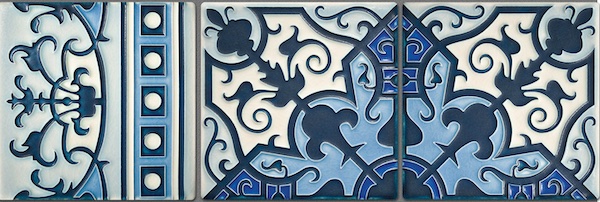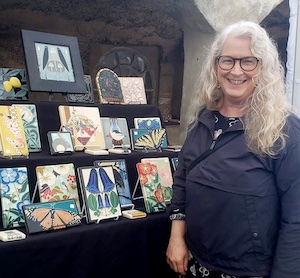
Motawi Tileworks – like its exceptional tiles – is crafted with intentionality. This company sets out a framework of guidelines in its philosophy that states: “We are a small giant company: We choose to be great instead of big.”
Motawi (motawi.com) hones this tall order to perfection with its “Motawi Mojo” and ongoing objectives. One of the main tenets of this philosophy establishes safety for employees – and owner – including physical safety, mental safety that treats co-workers with competence, integrity and friendliness, transparency and a guarantee of full-time employment. This attitude extends that to how customers are treated.
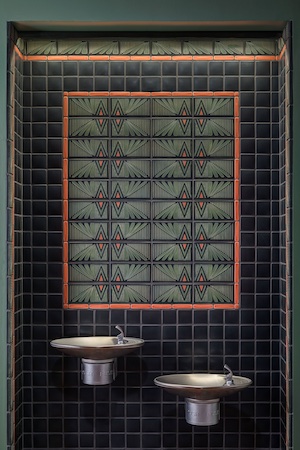

Motawi values its products for their design, quality and connection, and never aims for low price.
“I don’t fret about mainstream tastes,” says Nawal Motawi, owner and artistic director. “I can only make what I make and I’m not going after market share…As long as my work appeals to enough people to make the numbers work – in other words, as long as I have enough sales – I have a good business.”
This artistic manufacturer prides itself on authenticity and making “the world a better place by making products that people love, and demonstrating that a human-centered (as opposed to shareholder-value centered) workplace can be very successful.” The company eschews mediocre performance or products. It boldly proclaims, “We choose greatness over growth, if we can’t have both.”
That may explain why Motawi tiles are so extraordinary – delicate detailing, vibrant color, the luscious, satiny touch of the glaze against your skin. None of it got there by accident, and all of it is being shepherded by purpose and conscious intent.
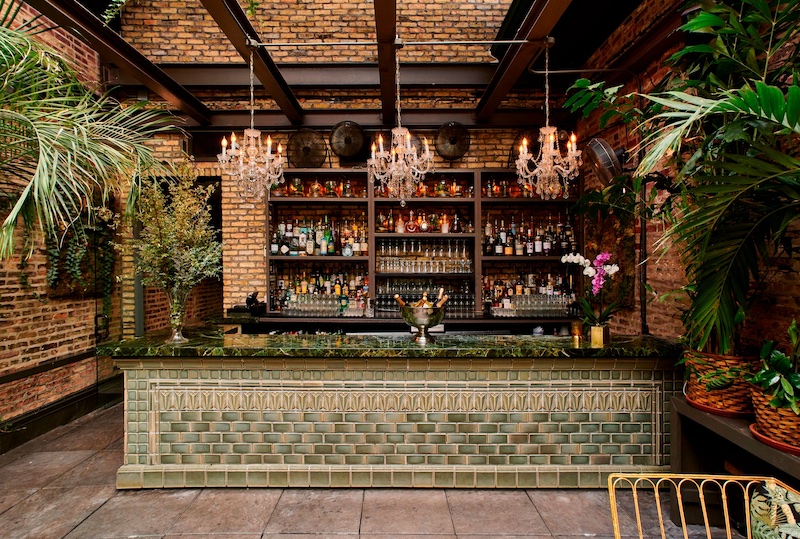

Company origins
This remarkable woman-owned business has its beginnings with Nawal Motawi, who rejected art school due to the gallery and critic culture of the world of painting and drawing, but returned to focus on the fine crafts. Working with ceramics, she became entranced by glaze and completely captivated when a visiting college professor at the University of Michigan took the class to see the tile murals at the 13 stations of the Detroit People Mover. “I was pretty dazzled by the prospect of being able to do a thing like that,” she said.
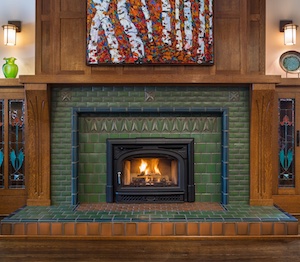

While working at Pewabic Pottery, she had the opportunity to fire her own works on the non-production parts of the kiln, so she made tiles after-hours, gaining confidence.
Motawi’s entrepreneurial DNA prompted a yearning for her own place. Her parents bought a house in Ann Arbor, primarily for its 600 sq. ft. cinderblock garage – the perfect place for an electric kiln! She and one of her three brothers partnered in business, and Motawi Tileworks was born in 1992.
After selling to showrooms for 18 years, Nawal bought her brother out in 2010, concentrating on installation work or work through the trades. In 2017, the company switched from the electric kiln to two Blaauw gas-fired kilns that require less maintenance and afford much greater control of temperature. About 45 people now work for Motawi. In addition, Nawal is the owner of Rovin Ceramics, which supplies clay and glazes for studios and school districts.
The tiles
Motawi makes two distinct types of tile: polychrome tile or “Art Tile” – raised-line multicolored tiles that stand alone as art pieces. They are sold via the Motawi factory store and online, and wholesale to gift and museum shops, kept in standard colorways for quick delivery.
“Installation Tiles” are field and relief tiles made to order for projects like fireplace facades, residential kitchens and bathrooms. These are available in 30 standard glaze colors and numerous standard sizes.
A blend of hand work and low-tech mechanization is used to create tiles. Raised-line tiles begin as vector drawings in Adobe Illustrator, that are imported into Rhino 3-D modeling software to create a digital model with raised lines. The reverse – or shell – is cut into modeling wax. This is filled with plaster to make the master model that is used to create air-release production molds in Ceramical plaster. Tiles are formed by pressing moist clay onto a RAM press using air-release technology, smoothing the edges of art tiles and cutting a notch in the back for hanging.
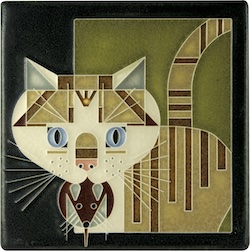

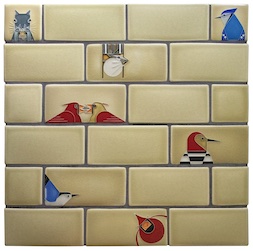

Glazing magic


Tiles are bisque-fired prior to glazing. And then the magic happens!
Relief and field tile are waxed on the back and hand-dipped in glaze, using a micrometer before every batch to assure the glaze is the correct thickness for the desired look.
Raised line tiles have design areas that are hand-filled with glaze using a bulb syringe with a special threaded tip. Then the tiles are fired once in the Blaauw kilns, according to a specific temperature curve.
“The velvety glaze surface is the result of our specific firing protocol and the inclusion of barium carbonate in the glaze formula,” Motawi said, cautioning, “Don’t eat off our tiles! We design our glazes to be interesting. We choose glazes that are sensitive to application thickness and sometimes change color on edges, not just melting to show the white clay body.”
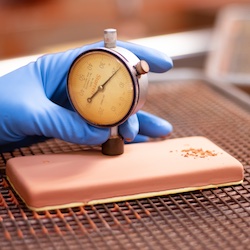

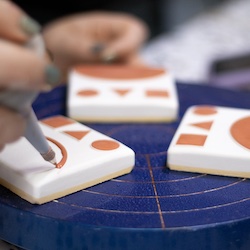

Designs
When it comes to tile designs, Nawal said, “I’m always concerned with creating drama, unity, and fullness in my pieces, while paying attention to the visual movement. I choose designs which have a personally enchanting pattern or motif and translate them into tile designs by magic – Okay, with my mysterious, intangible aesthetic sense,” she quipped. “This way I turn ‘just an image’ into a pleasing tile design that can stand on its own.”
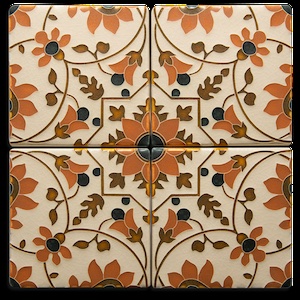

Motawi collects images of designs that intrigue her and will work well with the company’s techniques and colors, often from historical design styles like Art Nouveau, Arts & Crafts, Mid-Century, Art Deco, and Vienna Secession. After conferring with her staff, images are converted into vector artwork, with a goal of releasing about 10 new Art Tiles per year.
Motawi is also a licensee of The Charlie Harper Art Studio and The Frank Lloyd Wright Foundation, and holds a license agreement with artists Yoshiko Yamamoto and Carrie Phillips. Motawi and her art director draw tile designs tiles using copyrighted artwork that then must be approved by the licensor.
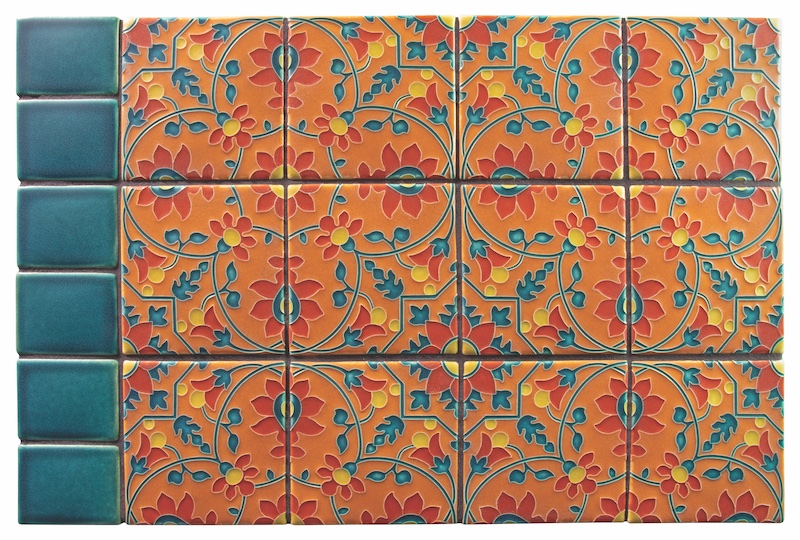

Kudos for the staff
Nawal Motawi has the highest regard for her staff and their appreciation and connection to art. And, she expects her leaders to keep learning throughout their careers.
“We train all of our people in the 14 Principles of Toyota Style Thinking, and our managers in Motawi’s specific management philosophy,” she explained. “What’s important is who our people are and how they behave, not their resumes or specific ceramic experience. Almost no new employee has been a tilemaker for Motawi before, so learning our processes on the job is the norm. We try to hire humble, hungry and smart and we invest a lot of time into choosing new staff members.”
Installing Motawi tiles
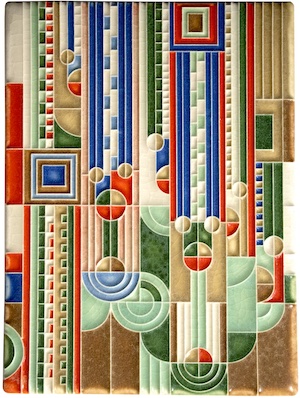

“Our three-person design department designs, sells and services our installation clients, which is about one third of our business,” she said. The team develops the layout and colors for the project with the Made-To-Order line.
Motawi encourages their installers to charge for time and materials, and not a flat fee, inspiring slow, careful work with the tiles. It’s recommended to check the fit during the installation and call Motawi if a question arises. Drawings and information accompany every project.
“Taping the relief and the raised line tiles is a part of life with Motawi tiles!” Nawal said. “Our tiles have nice ‘shoulders’ so setting the grout low enough to expose them gives the best result.”
Motawi tiles in the flesh
Want to see some of these stunning tiles in person? In addition to ordering some or stopping by the factory store in Ann Arbor, come to TileFest 24 at The TileWorks in Doylestown, Pa., May 18-19, 2024. They will be on display, and available for purchase. In addition, you can see the stunning work of David Ellison, who was Nawal’s brilliant and thought-provoking mentor when she was at Pewabic. Plus, his daughter Alexis (Kitchen Magician on IG) – who has been a member of the Motawi Bulb Glazing Staff for years – will display her incredible work.
Editorial Director and Senior Writer for TileLetter and TileLetter ARTISAN
Lesley Goddin has been writing and journaling since her first diary at age 11. Her journey has taken her through a career in publishing and publicity, landing her the editor position of TileLetter and its special publications in 2006. Her goal is to educate, inspire, recognize and encourage those in the tile industry -- especially the tile and stone contractor.


